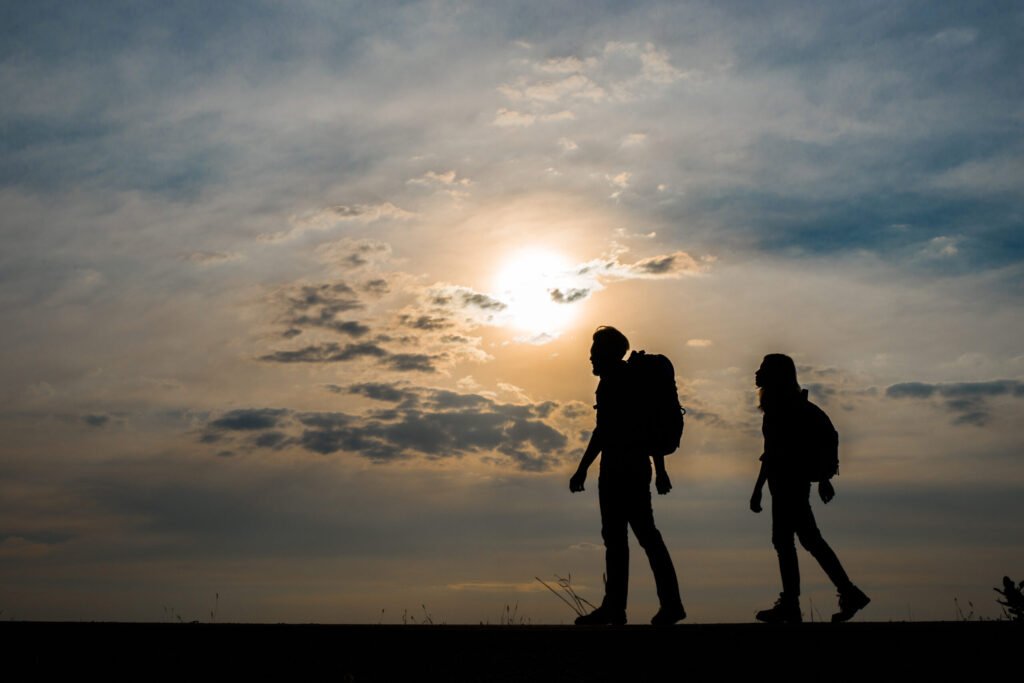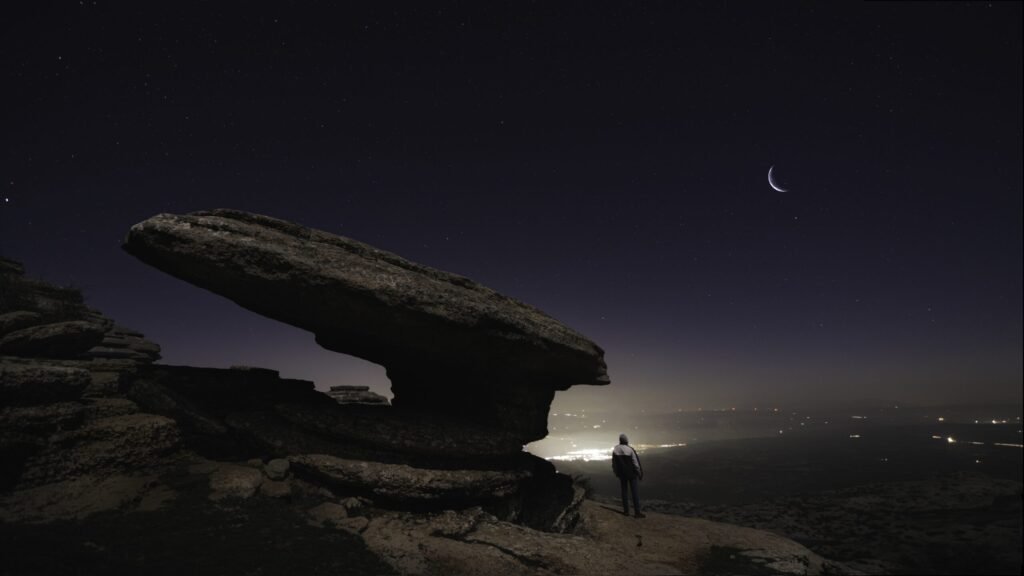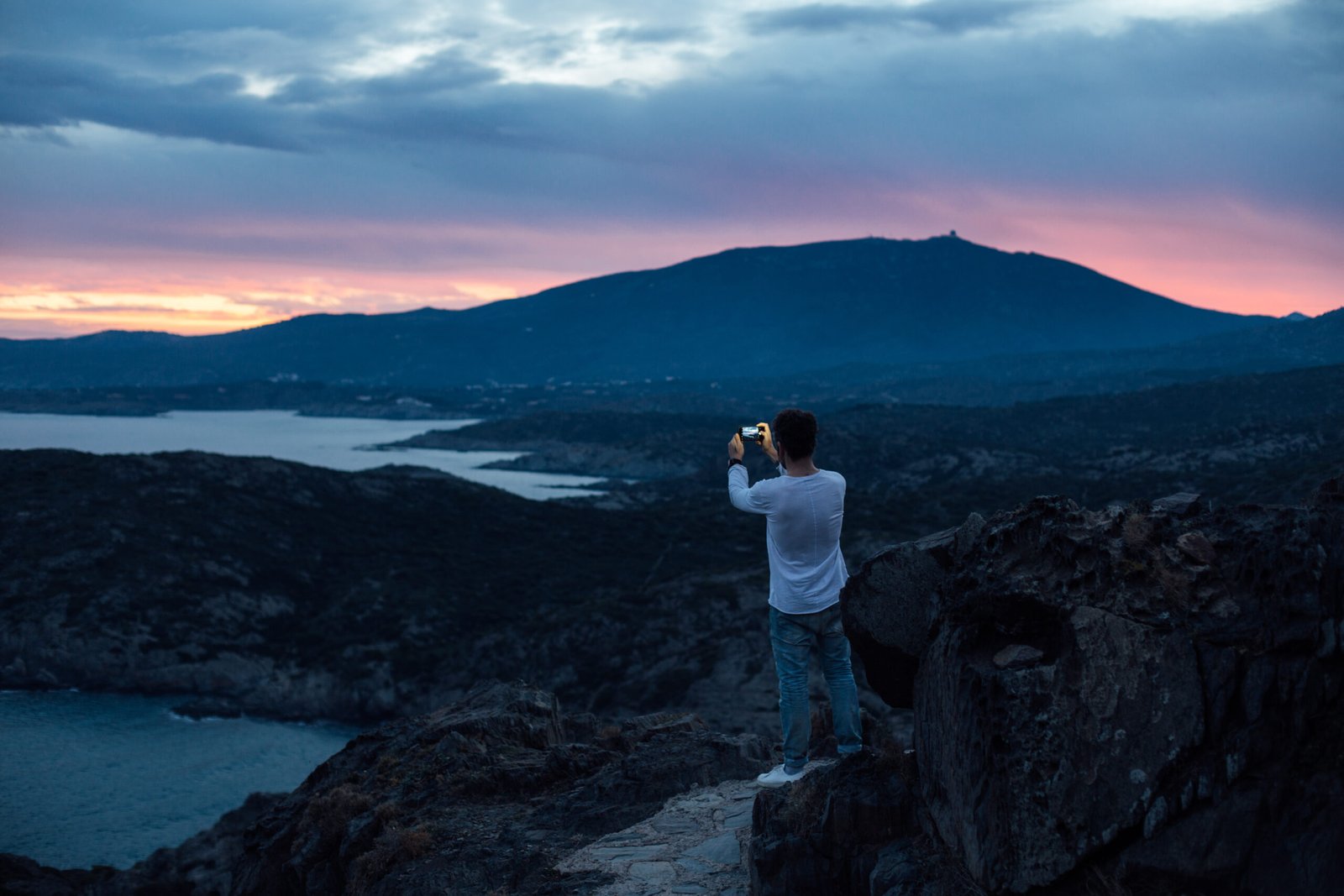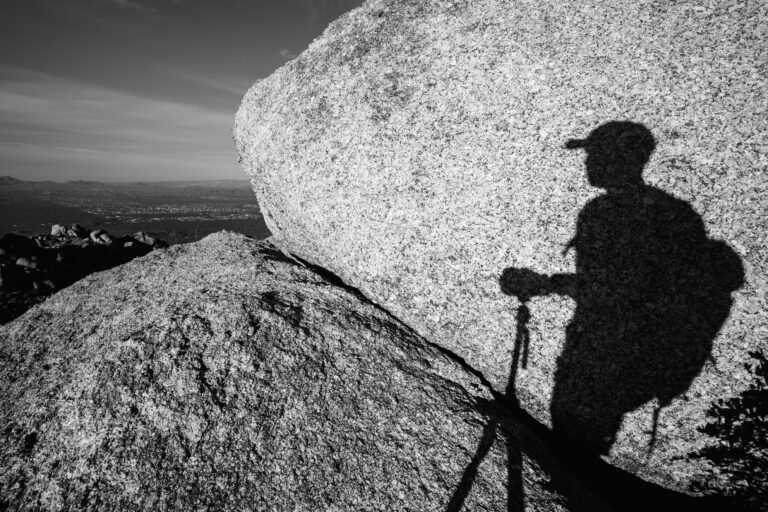Dark Sky Hiking: Chasing Stars and Avoiding Light Pollution
Embark on Dark Sky Hiking adventures, chasing stars and avoiding light pollution. Get our list of top trails for an unforgettable experience.
Imagine hiking under the stars, surrounded by the night’s serene atmosphere. As the sun sets, the world transforms, and a new kind of adventure begins. The familiar trail becomes mysterious, with nocturnal wildlife emerging and different senses taking precedence.
Experiencing nature under the celestial canopy is a unique thrill. Dark sky hiking offers an escape from light pollution, allowing you to witness the Milky Way and constellations in their full glory. With the right gear and knowledge, you can embark on a safe and rewarding stargazing adventure.

The Magic of Nighttime Trails
As the sun dips below the horizon, the hiking trails transform into a magical realm under the stars. The experience of hiking at night is vastly different from daytime hiking, offering a unique perspective on the natural world.
A Different World After Sunset
After sunset, the environment around us changes dramatically. The fading light allows our eyes to adjust to the darkness, revealing a night sky filled with thousands of stars. To fully appreciate this transformation, it’s advisable to arrive at the trailhead at dusk, allowing your eyes to gradually adjust to the dimming light. Selecting a spot with minimal tree canopy, such as an open meadow or lakeshore, can enhance the stargazing experience.
Escaping Light Pollution
One of the main attractions of dark sky hiking is the opportunity to escape the light pollution that plagues urban areas. By venturing into remote wilderness areas or designated Dark Sky Parks, hikers can witness the night sky in its full glory, with the Milky Way and numerous celestial objects visible to the naked eye. The contrast between the light-polluted skies of cities and the truly dark skies of these destinations is striking, making the experience emotionally moving for many. As noted by astronomers, “The darkness of the night sky is a treasure that allows us to connect with the universe in a profound way.”
Seeking out these dark sky destinations not only provides an unparalleled stargazing experience but also highlights the importance of preserving our night sky for future generations.
Benefits of Dark Sky Hiking
The benefits of dark sky hiking are multifaceted, ranging from personal growth to a heightened sensory experience. This unique form of hiking offers a chance to disconnect from the daytime world’s hustle and bustle and reconnect with nature in a profound way.
Solitude and Serenity
Dark sky hiking provides an unparalleled sense of solitude and serenity. As the trail quiets down with the setting sun, hikers can enjoy a peaceful night environment that is conducive to reflection and personal growth. The absence of daylight crowds allows for a more intimate experience with the natural surroundings.
Enhanced Sensory Experience
Hiking at night heightens your senses as your brain compensates for reduced visibility by enhancing hearing, touch, and even smell. The sounds of the forest or desert become more pronounced, from the hooting of owls to the rustling of nocturnal animals. Your peripheral vision becomes more sensitive, and the tactile experience of hiking changes as you become more aware of the terrain through your feet and trekking poles, developing a different relationship with the world around you. This heightened sensory awareness is a hallmark of the dark sky hiking experience.
Essential Gear for Stargazing Hikes
To fully immerse yourself in the beauty of the moon and stars, it’s vital to pack the right equipment for your hike. The right gear not only enhances your stargazing experience but also ensures your safety throughout the journey.
Lighting Equipment
Proper lighting is crucial for navigating through the dark. A reliable flashlight or headlamp is a must-have, along with extra batteries to avoid being left in the dark. Red light modes can help preserve your night vision, allowing you to enjoy the stars without disruption.
Navigation Tools
In addition to a good map, a compass is essential for navigating the trails at night. Consider bringing a GPS device or a smartphone with a GPS app to help stay on track. Familiarize yourself with the trail before heading out to minimize the need for navigation tools.
Comfort and Safety Items
Comfort and safety go hand in hand when stargazing. Bring insulated seating pads for comfortable viewing, and extra layers of clothing to stay warm as temperatures drop. Emergency bivvy sacks or space blankets can be lifesavers if the weather changes. Don’t forget high-calorie snacks and warm beverages to keep your energy up.
| Item | Purpose |
|---|---|
| Insulated Seating Pads | Comfort during stargazing |
| Extra Clothing Layers | Stay warm in dropping temperatures |
| Emergency Bivvy Sacks | Safety in changing weather |
| Collapsible Telescopes or Binoculars | Enhance stargazing experience |
Planning Your Dark Sky Hiking Adventure
A successful dark sky hiking experience hinges on choosing the right trail and timing it with celestial events. To make the most of your adventure, consider the transition period from sunset to complete darkness, which can take up to 90 minutes.
Choosing the Right Trail
Selecting a trail with minimal light pollution is crucial. Look for trails located in designated dark sky areas or national parks known for their clear skies. The Milky Way is a breathtaking sight on a clear night, and certain trails offer optimal views of this celestial wonder.
Timing Your Hike with Celestial Events
To maximize your stargazing experience, plan your hike around the lunar calendar. New moon periods offer the darkest skies, ideal for viewing faint objects like the Milky Way and distant galaxies. Research major meteor showers and time your hike to coincide with these spectacular events.
- Plan around the lunar calendar for the darkest skies.
- Research major meteor showers like the Perseids or Geminids.
- Consider seasonal variations in night sky features.
Understanding the Night Sky Transition
Understanding the night sky’s transition is crucial for maximizing your stargazing experience. As you plan your dark sky hiking adventure, it’s essential to grasp how the sky changes from sunset to full darkness.
From Sunset to Full Darkness
The period between sunset and full darkness is a critical time for stargazers. As the sun dips below the horizon, the sky gradually darkens, revealing more stars. To make the most of this time, find a location with minimal light pollution and an unobstructed view of the skies. An open meadow or lakeshore is ideal, as these areas typically have fewer obstructions and less artificial lighting.
Best Viewing Conditions
For the best views of celestial objects, including the Milky Way, consider the atmospheric conditions. Still, dry air at higher elevations usually provides the sharpest images. Check the weather forecast for cloud cover and humidity, as these factors can significantly impact visibility. Scheduling your hike during a new moon phase will also enhance your stargazing experience by reducing moonlight interference.
Top Dark Sky Hiking Trails in America
From coast to coast, America’s dark sky trails beckon to stargazers and hikers alike, offering unforgettable experiences under the stars. These trails, located in some of the country’s most remote and darkest areas, provide not only spectacular views of the night sky but also a chance to connect with nature in its most pristine form.
Hermitage Point Trail – Grand Teton National Park, Wyoming
The Hermitage Point Trail in Grand Teton National Park offers a serene hiking experience under the stars. This trail is known for its minimal light pollution, making it an ideal spot for stargazing.
Nauset Marsh Trail – Cape Cod National Seashore, Massachusetts
Nauset Marsh Trail, located within the Cape Cod National Seashore, is a haven for those seeking to enjoy the night sky away from urban light pollution. The trail’s serene marshlands offer a unique stargazing experience.
Harmony Borax Works Interpretive Trail – Death Valley National Park, California
Death Valley National Park’s Harmony Borax Works Interpretive Trail is a historic and astronomically significant hiking trail. It offers an unforgettable stargazing experience due to the park’s exceptionally dark skies.
Hidden Lake Overlook – Glacier National Park, Montana
Glacier National Park’s Hidden Lake Overlook trail is renowned for its breathtaking mountain vistas and dark skies. Hikers can enjoy spectacular stargazing after sunset.
Anhinga Trail – Everglades National Park, Florida
The Anhinga Trail in Everglades National Park is a unique dark sky hiking destination. Known for its wildlife, the trail offers a chance to see nocturnal animals under the stars.
Ridgeline Trail – Headlands Dark Sky Park, Michigan
Headlands Dark Sky Park’s Ridgeline Trail is a premier destination for stargazers. The park’s Gold Tier Dark Sky Park designation ensures minimal light pollution, offering crystal-clear views of the night sky.
Flat Top Trail – Peaks of Otter, Virginia
The Flat Top Trail at Peaks of Otter is a great spot for night hiking and stargazing. The trail’s relatively easy terrain makes it accessible for hikers of various skill levels.
Lost Mine Trail – Big Bend National Park, Texas
Lost Mine Trail in Big Bend National Park is a must-hike for stargazers. The trail’s location within one of the darkest national parks in the contiguous United States makes it an ideal spot for viewing the night sky.
Big Bend National Park is recognized for having the least light pollution of any national park in the lower 48 states. The 5-mile round-trip hike climbs through diverse ecosystems to a ridgeline with expansive views across Pine Canyon and into Mexico’s Sierra del Carmen nature reserve.
International Dark Sky Parks Explained
The International Dark-Sky Association plays a crucial role in preserving the night sky by designating Dark Sky Parks. These are areas with exceptionally starry skies and minimal light pollution.
The International Dark-Sky Association
The International Dark-Sky Association is a non-profit organization dedicated to preserving the natural night sky. It achieves this by promoting Dark Sky Parks and educating the public about the importance of reducing light pollution.
Certification Requirements
To become a Dark Sky Park, an area must meet specific criteria, including having quantifiable evidence of exceptional night sky quality. Applicants must also implement a comprehensive Lighting Management Plan and ensure public access to the land. The certification process, which typically takes 1-3 years, involves substantial documentation and sometimes significant modifications to lighting infrastructure.
Key requirements include:
- Quantifiable evidence of exceptional night sky quality
- A comprehensive Lighting Management Plan
- Public land access for education and enjoyment
- Ongoing commitment to dark sky education and outreach programs
America’s Premier Dark Sky Destinations
For those seeking astronomy-focused hiking experiences, the U.S. offers incredible dark sky parks. These destinations provide not only stunning views of the night sky but also unique hiking opportunities amidst exceptionally dark environments.
Texas Dark Sky Territory
The Texas Dark Sky Territory is a haven for stargazers and hikers. With its minimal light pollution, the territory offers breathtaking views of the night sky. Hikers can enjoy trails while experiencing the incredible darkness of the region, making it an ideal location for both stargazing and hiking.
The International Dark-Sky Association has recognized several areas within Texas for their dark skies, making it a premier destination for those seeking astronomy-focused hiking experiences.

Western National Parks
Western national parks lead America’s dark sky preservation efforts, with parks like Death Valley National Park, Grand Canyon, Bryce Canyon, Capitol Reef, and Great Basin achieving International Dark Sky Park designation. These parks offer some of the darkest skies in the country, providing hikers with unparalleled stargazing opportunities.
The National Park Service’s Night Sky Team works to measure, protect, and interpret dark skies across the park system, recognizing them as important natural resources. This effort enhances the hiking experience by preserving the natural darkness, allowing for better stargazing and a more immersive experience in nature.
Wildlife Encounters During Night Hikes
As the sun dips below the horizon, the trail transforms into a nocturnal wonderland, teeming with life. Night hiking offers a unique chance to observe wildlife in their natural habitat, under the cover of night.
Nocturnal Animals to Watch For
When hiking at night, keep an eye out for nocturnal animals such as owls, bats, and raccoons. These creatures are most active after dark, and their behaviors can be fascinating to observe. Stay alert for animals foraging close to the trail and give them a wide berth as you pass.
Respectful Wildlife Observation
To minimize your impact on wildlife, it’s crucial to use light judiciously. Using red light instead of white light can significantly reduce disruption to nocturnal animals. Maintaining a safe distance from wildlife is also essential, as animals may be more easily startled at night. Additionally, understanding seasonal wildlife patterns and storing food properly can help avoid unintentional disturbance, especially in a park setting.
Stargazing Tips for Hikers
The night sky is a vast and wondrous place, full of mysteries waiting to be unraveled by hikers with an interest in astronomy. To enhance your stargazing experience, consider the following tips.
Using Star Charts and Apps
Consider investing in a stargazing app to help you identify planets and constellations. Some of the best stargazing apps for hikers include those that provide real-time sky maps and information on celestial events.
Identifying Constellations and Planets
- Begin constellation identification with easily recognizable asterisms like the Big Dipper, which serves as a pointer to other key stars and constellations.
- Planets appear as bright, non-twinkling points of light that often outshine surrounding stars – Venus, Jupiter, Mars, and Saturn are frequently visible to the naked eye.
- Seasonal sky changes bring different constellations into view throughout the year – summer features the Milky Way’s bright core with Sagittarius and Scorpius, while winter showcases Orion and Taurus.
- The zodiacal constellations follow the ecliptic (the sun’s apparent path) and serve as backgrounds for planetary movements, making them useful reference points for planet identification.
- Learning to estimate angular distances in the sky using your hand at arm’s length helps with navigation between constellations – a fist spans approximately 10 degrees, while a pinky width covers about 1 degree.
Night Photography on the Trail
For those who love both hiking and astronomy, night photography on the trail offers a unique adventure. Capturing the beauty of the night sky requires a combination of the right equipment and techniques.
Essential Camera Equipment
To capture stunning night sky photos, you’ll need a few essential pieces of camera equipment. A DSLR or mirrorless camera with manual controls is crucial, along with a wide-angle lens (between 10-24mm) and a sturdy tripod to minimize camera shake.
Additional accessories like a remote shutter release or the camera’s self-timer can help reduce vibrations, ensuring sharper images.
Techniques for Capturing the Milky Way
Capturing the Milky Way requires a good understanding of your camera settings and composition techniques. Use manual mode with an ISO between 1600-6400, an aperture of f/2.8 or wider, and exposure times between 15-30 seconds to capture the galaxy’s details.
The “500 Rule” can help determine the maximum exposure time before stars begin to trail: divide 500 by your lens’s focal length to find the optimal exposure in seconds.
Composition techniques, such as incorporating foreground elements like trees or mountains, can add depth to your photos. Focusing on a bright star or distant light using live view at maximum magnification can achieve the sharpest results.
Safety Considerations for Night Hiking
To enjoy the thrill of night hiking under the stars, you must first address the key safety concerns. Dark sky hiking can be a magical experience, but it requires careful planning.
Navigation Challenges
Navigating in the dark can be particularly challenging. It’s essential to bring red light or a flashlight to preserve your night vision. Using a map, compass, and GPS device can help you stay on track in the area you’re hiking.
- Use a map and compass to navigate.
- Bring a GPS device as a backup.
- Consider using a guided tour if you’re unfamiliar with the terrain.
Emergency Preparedness
Being prepared for emergencies is crucial when hiking at night. Stock your backpack with essentials like a first aid kit, extra batteries, and a means of communication.
- Pack a first aid kit and know how to use it.
- Carry emergency communication devices like satellite messengers.
- Bring extra light sources, such as a headlamp and flashlight.
Seasonal Considerations for Dark Sky Hiking
As the seasons change, the night sky transforms, offering diverse opportunities for dark sky hiking enthusiasts. Understanding these seasonal variations can significantly enhance your stargazing experience.
Summer vs. Winter Stargazing
Summer and winter offer distinct stargazing experiences. Summer skies are characterized by the presence of the Milky Way, visible on clear nights. In contrast, winter skies often provide darker conditions due to longer nights, making it easier to spot stars and constellations. Planning your hike according to these seasonal changes can optimize your viewing experience.
Meteor Showers and Celestial Events
Major annual meteor showers like the Perseids (August), Geminids (December), and Leonids (November) are significant attractions for dark sky hikers. To maximize viewing, plan your hikes around new moon periods for the darkest skies. Other celestial events such as solar eclipses, lunar eclipses, and planetary conjunctions also offer spectacular viewing opportunities. Staying informed about these events through astronomy news sources can help you plan your next dark sky hiking adventure.
- Plan your dark sky hikes around major meteor showers for spectacular displays.
- Schedule your hikes during new moon periods for the best viewing conditions.
- Stay informed about celestial events like solar eclipses and planetary conjunctions.
Ranger-Led Night Programs and Star Parties
Ranger-led night programs offer a unique opportunity to explore the night sky with expert guidance. These programs are designed for those who are new to dark sky hiking or looking to enhance their stargazing experience.
Finding Guided Experiences
To find ranger-led night programs, search for “national park ranger night sky programs” or check the official websites of dark sky parks and national parks. Many parks offer guided night hikes and star parties, especially during peak celestial events.
Benefits of Expert Guidance
The benefits of joining a ranger-led night program include:
- Access to specialized knowledge: Professional astronomers and trained rangers provide insights that enhance the stargazing experience.
- High-quality equipment: Guided programs often include access to telescopes and astronomical equipment.
- Safety: Guides lead participants safely through dark environments, addressing safety concerns.
- Cultural and historical context: Knowledgeable guides connect celestial phenomena to human history and scientific discoveries.
By joining a ranger-led night program, participants can gain a deeper appreciation for the night skies and enjoy a more fulfilling experience in park environments.
Preserving the Night Sky for Future Generations
As we conclude our journey through the world of Dark Sky Hiking, it’s essential to reflect on the importance of preserving our night skies. The U.S. is home to numerous Dark Sky Parks, areas with exceptionally starry skies and minimal light pollution, as designated by the International Dark-Sky Association.
To protect these sanctuaries, we must address the growing issue of light pollution. Simple actions like using shielded outdoor lighting and warm-colored bulbs can make a significant difference. Community advocacy for responsible lighting ordinances has also proven effective in places like Flagstaff, Arizona, and Borrego Springs, California.
Supporting International Dark Sky Place designations and educational outreach programs helps expand protected dark sky territories and builds broader public support for preservation efforts. By working together, we can preserve the natural beauty of our night skies for future generations.


